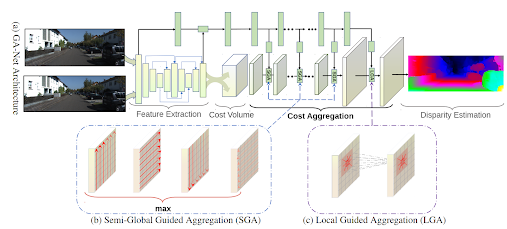上一篇文章 Stereo Matching:Semi-Global Matching 列了一些傳統 stereo matching 的參考資料,而本文會介紹一些利用深度學習方法解決 stereo matching 的文章。
GC-Net
GC-Net [1] 的文章標題為 End-to-End Learning of Geometry and Context for Deep Stereo Regression。直接來看架構圖:
以下為一些筆記:
- 輸入為 stereo images,首先各自通過 2D convolution 以及 residual block 來取得 feature map。
- 將兩個 feature map 連接起來成為一個四維的 cost volume,維度為 H*W*D*F,其中 D 為所有可能的 disparity 的值的數目,F 為 feature map 的維度。
- 利用 3D convolution 學習 feature map 至 cost volume 的關係式。
- 3D deconvolution 來 upsample cost volume。
- 利用 soft argmax 求出最有可能的 disparity 值。Soft argmax 的式子為:\(\sum_{d=0}^{D_{max}} d \times \sigma(-c_{d})\),意思是先將 cost volume 中的數字取負號使得 cost 越小的 element 值越大,再取 softmax (\(\sigma 函數\)),最後再加權平均算出最後的 disparity。
- Loss 函數為真正的 disparity 與估計的 disparity 的 L1 norm。
GA-Net
GA-Net [2] 的文章標題為 GA-Net: Guided Aggregation Net for End-to-end Stereo Matching,為GC-Net 與 SGM 結合在一起的方法。以下為架構圖:
以下為一些筆記:- Feature map 與 cost volume 的部分與 GC-Net 相同。
- SGA layer (Semi-Global Guided Aggregation)參考了 SGM 的演算法。以下為此 layer 的式子:第一行代表的是原始 cost volume 的 cost,第二行為在 p-r 點上 d disparity 的 cost,其中 r 代表四個方向中的其中一個。第三與第四行為 disparity 相差 1 的 cost,而第五行代表所有其他 disparity 的差大於 1 的情形。為了防止 cost 無限制地變大,在此加入了五個 weight 相加必須等於 1 的限制。
- 這些 weights 從哪來的呢?從上面的 branch(稱為 Guidance Branch)學來的。假設 cost volume 的維度為 H*W*D*F 的話,guidance branch 提供的 weight 維度必須為 4(4 個方向)* 5(5 個 weight)* H * W * D。
- LGA layer (Local Guided Aggregation)可以當成是 disparity map 的 refinement。以下為 LGA layer 的式子:
此 local filter 為 K*K*3 的 filter;本文的例子中 K 為 5,也就是從 local 的 5*5 window 中來 aggregate,而 3 為三個 disparity(d, d-1, d+1)的 aggregation,因此這個 weight layer 的維度為 H*W*75。此 weight layer 也是從 Guidance Branch 而來。
ACVNet
ACVNet [3] 的文章標題為 Attention Concatenation Volume for Accurate and Efficient Stereo Matching。其設計了 attention concatenation volume 來取代以前的 cost volume 設計。首先來看它與其他方法的比較:
以下為架構圖:
Attention 的部分主要來自 MAPM (multi-level adaptive patch matching),也就是用 Atrous convolution (dilated convolution) 來計算 feature map,這樣能得到在不同 scale 之下各自的 attention。在算完 attention map 以後,就與 concatenated cost volume 用個 element wise 乘法得到 attention concatenation volume。之後的 layers 跟其他的文章都相當類似:cost aggregation 與 disparity prediction。最後附上一個 atrous convolution 的示意圖:
參考資料
[1] End-to-End Learning of Geometry and Context for Deep Stereo Regression
[2] GA-Net: Guided Aggregation Net for End-to-end Stereo Matching
[3] Attention Concatenation Volume for Accurate and Efficient Stereo Matching







沒有留言:
張貼留言